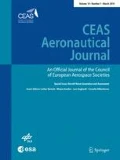Abstract
Several crosswind-related incidents show that landing under heavy crosswind conditions can be challenging for pilots and may pose a threat to aviation or at least lead to higher pilot workload and/or irregularities in operations. For transport aircraft the common approach technique for crosswind landings is the so-called crabbed approach with wings level and a windward heading correction. This technique requires alignment of the aircraft with the runway prior to touchdown in order to keep lateral loads of the landing gear and tyres as low as possible and to maintain the controllability on ground after touchdown. The German Aerospace Center Institute of Flight Systems has used the idea of steerable main gears and developed a crosswind landing assistance system. During approach all gear struts are automatically aligned with the runway so that no decrab manoeuvre is required. On ground the assistance system uses each steerable landing gear, differential braking, and the aerodynamic control surfaces to control and stabilise the aircraft. After touchdown the aircraft is automatically aligned with the runway centreline and the still existing crab angle is slowly reduced. A simulator study with pilots in the loop using a model of a typical medium range transport aircraft was conducted in order to evaluate the benefits of such a landing technique. The study revealed that not only the aircraft controllability could be improved by landing in crabbed motion under strong crosswind conditions, but that the side forces acting on the landing gear can be reduced significantly as well. It was also shown that the use of steerable main landing gears is able to enlarge the spectrum of autoland operations, which is relatively limited at present in terms of maximum allowable crosswinds. All together the system has shown to be able to improve flight safety, lower the risk of weather-related delays due to go-arounds or diversions, and it also reduces structural loads on the landing gear during touchdown and landing.

















Similar content being viewed by others
Abbreviations
- CLAS:
-
Crosswind landing assistance system
- ECAM:
-
Electronic centralised aircraft monitoring
- EFCS:
-
Electronic flight control system
- EFIS:
-
Electronic flight instrument system
- FCOM:
-
Flight crew operating manual
- FCS:
-
Flight control system
- FCU:
-
Flight control unit
- ILS:
-
Instrument landing system
- NDB:
-
Non-directional beacon
- NTSB:
-
National Transportation Safety Board
- UAV:
-
Unmanned aerial vehicle
- VOR:
-
VHF omnidirectional radio range
- \(F_{x}\) :
-
Longitudinal force
- \(F_{y}\) :
-
Lateral force
- \(F_{z}\) :
-
Vertical force
- \(F_{\text{S}}\) :
-
Spring force
- \(F_{\text{D}}\) :
-
Damping force
- \(f_{\text{O}}\) :
-
Oleo deflection
- \(n_{\text{y}}\) :
-
Lateral load factor
- \(p_{\text{T}}\) :
-
Tyre pressure
- \(r_{K}\) :
-
Yawing rate in track-fixed coordinates
- \(u_{K}\) :
-
Longitudinal velocity in track-fixed coordinates
- \(v_{K}\) :
-
Lateral velocity in track-fixed coordinates
- \(\eta\) :
-
Steering angle
- \(\mu_{\text{B}}\) :
-
Brake friction coefficient
- \(\mu_{\text{R}}\) :
-
Roll friction coefficient
- \(\tau\) :
-
Skid angle
References
NOAA National Oceanic and Atmospheric Administration, National Climatic Data Center. http://www.ncdc.noaa.gov/data-access/quick-links#dsi-3505
N.N., Flight Safety Foundation—Approach and Landing Accident Reduction—Briefing Note 8.7 —Crosswind Landings, Flight Safety Digest (2000)
N.N., Airbus Flight Operations Briefing Notes—Landing Techniques—Crosswind Landings FOBN Reference FLT_OPS-LAND-SEQ05-REV03-MAR.2008
N.N., Air Accident Investigation Branche, AAIB Bulletin: 7/2007, G-VSHY, EW/C2006/02/04
The Boeing 737 Technical Site http://www.b737.org.uk
Hebborn, A., A380 Landing Gear and Systems—The feet of the Plane, DGLR—Hamburg (2008)
Fischenberg. D., A Validated Dynamic Simulation Model for VFW-614 Ground Handling, DLR Institute Report IB 111-1998/33 (1998)
N.N., A320 Aircraft Maintenance Manual, DG. AMM AEF, Issue Aug. 95, 1995
Fernando, B.: Modelling of a steerable main landing gear and development of a crosswind landing assistance system, DLR Institute Report IB 111-2010/07 (2010)
Raab, C.: Aerodynamikmodell für das Forschungsflugzeug A320 ATRA, DLR Institute Report IB 111-2010/45 (2010)
Raab, C.: Flugdynamisches Simulationsmodell A320-ATRA-Validierungsversuche und Bewertung der Modellgüte, DLR Institute Report IB 111-2012/43 (2012)
N.N., A320 Flight Crew Operating Manual, Vol. 3 Flight Operations, Issue Date 01-Jun-2009,
Schwarz, C, Hahn, K.-U.: Subjective Wake Vortex Encounter Evaluation, DLR Institute Report IB 111-2011/46 (2011)
Acknowledgments
The authors would like to thank all pilots who participated on the simulator campaign for their cooperation. Special thanks are given to the DLR-external airline pilots, who offered their contribution voluntarily in their free time and always with great commitment. Furthermore, the ambitious work of Bernhard Fernando and Thomas Sassmann shall be mentioned, who performed most of the system development as student assistants.
Author information
Authors and Affiliations
Corresponding author
Additional information
This paper is based on a presentation at the German Aerospace Congress, September 10–12, 2013, Stuttgart, Germany.
Rights and permissions
About this article
Cite this article
Vechtel, D., Meissner, U.M. & Hahn, KU. On the use of a steerable main landing gear for crosswind landing assistance. CEAS Aeronaut J 5, 293–303 (2014). https://doi.org/10.1007/s13272-014-0107-2
Received:
Revised:
Accepted:
Published:
Issue Date:
DOI: https://doi.org/10.1007/s13272-014-0107-2




